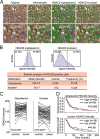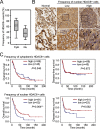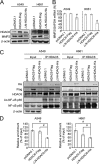Nuclear HDAC6 inhibits invasion by suppressing NF-κB/MMP2 and is inversely correlated with metastasis of non-small cell lung cancer
- PMID: 26388610
- PMCID: PMC4745796
- DOI: 10.18632/oncotarget.4749
Nuclear HDAC6 inhibits invasion by suppressing NF-κB/MMP2 and is inversely correlated with metastasis of non-small cell lung cancer
Abstract
Histone deacetylase 6 (HDAC6) is a unique member of the histone deacetylase family. Although HDAC6 is mainly localized in the cytoplasm, it can regulate the activities of the transcription factors in the nucleus. However, a correlation of intracellular distribution of HDAC6 with tumor progression is lacking. In this study, we found that a low frequency of nuclear HDAC6-positive cells in tumors was associated with distant metastasis and a worse overall survival in 134 patients with non-small cell lung cancer (NSCLC). Ectopic expression of wild-type HDAC6 promoted migration and invasion of A549 and H661 cells. However, the enforced expression of nuclear export signal-deleted HDAC6 inhibited the invasion but not the migration of both cell lines. The inhibitory effect of nuclear HDAC6 on invasion was mediated by the deacetylation of the p65 subunit of nuclear factor-κB, which decreased its DNA-binding activity to the MMP2 promoter, leading to the downregulation of MMP2 expression. Our findings indicated that the loss of nuclear HDAC6 may be a potential biomarker for predicting metastasis in patients with NSCLC.
Keywords: HDAC6; MMP2; NF-κB; lung cancer; metastasis.
Conflict of interest statement
The authors declare no conflict of interest.
Figures




References
-
- Yang PH, Zhang L, Zhang YJ, Zhang J, Xu WF. HDAC6: physiological function and its selective inhibitors for cancer treatment. Drug Discov Ther. 2013;7:233–242. - PubMed
-
- Verdel A, Khochbin S. Identification of a new family of higher eukaryotic histone deacetylases. Coordinate expression of differentiation-dependent chromatin modifiers. The Journal of biological chemistry. 1999;274:2440–2445. - PubMed
-
- Bertos NR, Gilquin B, Chan GK, Yen TJ, Khochbin S, Yang XJ. Role of the tetradecapeptide repeat domain of human histone deacetylase 6 in cytoplasmic retention. J Biol Chem. 2004;279:48246–48254. - PubMed
Publication types
MeSH terms
Substances
LinkOut - more resources
Full Text Sources
Other Literature Sources
Medical
Research Materials
Miscellaneous

